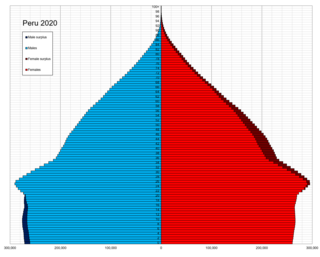
This is a demography of the population of Peru including population density, ethnicity, education level, the health of the populace, economic status, religious affiliations and other aspects of the population.

Peon usually refers to a person subject to peonage: any form of wage labor, financial exploitation, coercive economic practice, or policy in which the victim or a laborer (peon) has little control over employment or economic conditions. Peon and peonage can refer to both the colonial period and post-colonial period of Latin America, as well as the period after the end of slavery in the United States, when "Black Codes" were passed to retain African-American freedmen as labor through other means.
In social anthropology, matrilocal residence or matrilocality is the societal system in which a married couple resides with or near the wife's parents. Thus, the female offspring of a mother remain living in the mother's house, thereby forming large clan-families, typically consisting of three or four generations living in the same place.

Loreto is Peru's northernmost department and region. Covering almost one-third of Peru's territory, Loreto is by far the nation's largest department; it is also one of the most sparsely populated regions due to its remote location in the Amazon Rainforest. Its capital is Iquitos.
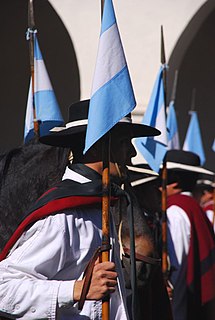
The culture of South America draws on diverse cultural traditions. These include the native cultures of the peoples that inhabited the continents prior to the arrival of the Europeans; European cultures, brought mainly by the Spanish, the Portuguese and the French; African cultures, whose presence derives from a long history of New World slavery; and the United States, particularly via mass culture such as cinema and TV.

The Machiguenga are an indigenous people who live in the Amazon Basin jungle regions of southeastern Peru, east of Machu Picchu and close to the borders of Bolivia and Brazil. Their population is about 7700. Theirs is a hunter-gatherer culture for the most part, although they also practice slash and burn agriculture. The main crop grown is cassava, and their main source of protein is the paca, a large 6–12 kg (13–26 lb) rodent. During the dry season, the Machiguenga also use fishing to supplement the protein in their diet.

The Urarina are an indigenous people of the Peruvian Amazon Basin (Loreto) who inhabit the valleys of the Chambira, Urituyacu, and Corrientes Rivers. According to both archaeological and historical sources, they have resided in the Chambira Basin of contemporary northeastern Peru for centuries. The Urarina refer to themselves as Kachá, while ethnologists know them by the ethnonym Urarina.
Bride service has traditionally been portrayed in the anthropological literature as the service rendered by the bridegroom to a bride's family as a bride price or part of one. Bride service and bride wealth models frame anthropological discussions of kinship in many regions of the world.
The Chambira River is a major tributary river of the Marañón River, and has been the traditional territory of the Urarina peoples for at least the past 350 years, if not much longer. Located in the Amazon jungle of Peru, otherwise known as the Selva, this river is a tropical waterway with many purposes. There is a diversity of plants and animals in this region which creates a unique ecosystem around the Chambira River. Made up of "palm-swamps," the region takes its name from the Chambira palm. Until relatively recently, the Chambira Basin has not been the focus of mapping by the Spanish empire or the Peruvian nation. No major geographical surveys of the Chambira Basin were mounted during the nineteenth century heyday of exploration. It was not until the 1970s discovery of hydrocarbons in the region and subsequent indigenous peoples' mobilization and government-backed neo-liberal legislation that the Chambira River's lands have been mapped.

The Bora are an indigenous tribe of the Peruvian, Colombian, and Brazilian Amazon, located between the Putumayo and Napo rivers.

The Indigenous peoples of Peru, or Native Peruvians, comprise a large number of ethnic groups who inhabit territory in present-day Peru. Indigenous cultures developed here for thousands of years before the arrival of the Spanish in 1532.

Peruvians are the citizens of Peru. There were Andean and coastal ancient civilizations like Caral, which inhabited what is now Peruvian territory for several millennia before the Spanish conquest in the 16th century; Peruvian population decreased from an estimated 5–9 million in the 1520s to around 600,000 in 1620 mainly because of infectious diseases carried by the Spanish. Spaniards and Africans arrived in large numbers in 1532 under colonial rule, mixing widely with each other and with Native Peruvians. During the Republic, there has been a gradual immigration of European people. Chinese and Japanese arrived in large numbers at the end of the 19th century.
As of 2017, South America has an estimated population of 418.76 million people.
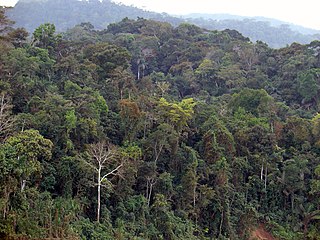
Peruvian Amazonia is the area of the Amazon rainforest included within the country of Peru, from east of the Andes to the borders with Ecuador, Colombia, Brazil and Bolivia. This region comprises 60% of the country and is marked by a large degree of biodiversity. Peru has the second-largest portion of the Amazon rainforest after the Brazilian Amazon.
Urarinas District is one of five districts of the province Loreto in Peru. In addition to Jivaroan-speaking peoples, a major indigenous Amazonian group residing in this District is the Urarina people.
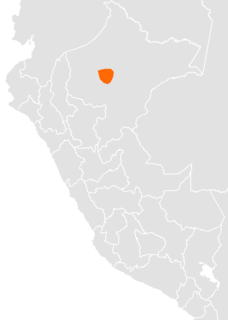
Urarina is an isolated language spoken in Peru, specifically in the Loreto Region of Northwest Peru, by the Urarina people. There are around 3,000 speakers in Urarinas District. It uses a Latin script. It is also known as Itucali, Simacu or Shimacu.

The Amazon rainforest is the largest rainforest in the world, covering an area of 6,000,000 km2. It represents over half of the planet's rainforests and comprises the largest and most biodiverse tract of tropical rainforest in the world. This region includes territory belonging to nine nations. The majority of the forest is contained within Brazil, with 60%, followed by Peru with 13%, Colombia with 10%, and with minor amounts in Venezuela, Ecuador, Bolivia, Guyana, Suriname and French Guiana.

Eduardo Batalha Viveiros de Castro is a Brazilian anthropologist and a professor at the National Museum of the Federal University of Rio de Janeiro.
Joanna Overing is an American anthropologist based in Scotland. She has conducted research on egalitarianism, indigenous cosmology, philosophical anthropology, aesthetics, the ludic and linguistics through fieldwork in Amazonia. She has extensively studied indigenous Piaroa people in the Orinoco basin of Venezuela.
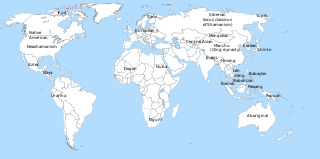
Shamanism is a religious practice found in many parts of the world. Shamanism can be found in many different forms that can vary greatly by region.













